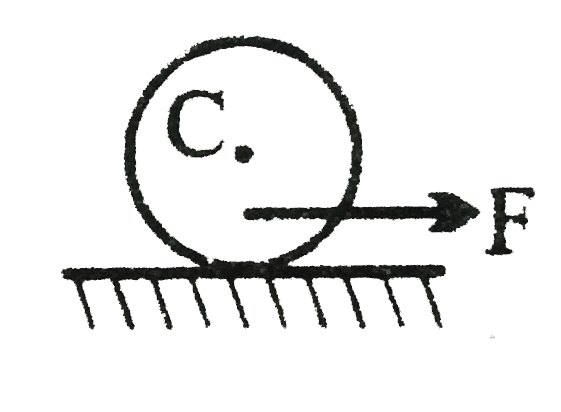U is the PE of an oscillating particle and F is the force. if acting on it at a given instant. Which of the following true?
UF+x=0
2UF+x=0
FU+x=0
F2U+x=0
The correct Answer is:B
To solve the problem, we need to analyze the relationship between the potential energy (U), the force (F), and the displacement (x) of an oscillating particle in simple harmonic motion (SHM).
1. Understanding Potential Energy (U):
The potential energy of an oscillating particle in simple harmonic motion is given by the formula:
U=12kx2
where k is the spring constant and x is the displacement from the equilibrium position.
Hint: Remember that potential energy in SHM is related to the displacement squared and the spring constant.
2. Understanding Force (F):
The force acting on the particle in SHM is given by Hooke's law:
F=−kx
The negative sign indicates that the force acts in the opposite direction of the displacement.
Hint: The force in SHM is directly proportional to the displacement and acts in the opposite direction.
3. Expressing k in terms of F and x:
From the force equation, we can express k as:
k=−Fx
Hint: Isolate k to relate it to force and displacement.
4. Substituting k into the Potential Energy Equation:
Substitute the expression for k back into the potential energy equation:
U=12(−Fx)x2
Simplifying this gives:
U=−F2x
Hint: When substituting, ensure to simplify carefully to maintain the relationships.
5. Rearranging the Equation:
Rearranging the equation gives:
U+F2x=0
This can be further manipulated to express a relationship between U and F:
2U+Fx=0
Hint: Look for ways to rearrange the equation to find relationships between the variables.
6. Final Expression:
Dividing the entire equation by F (assuming F≠0) gives:
2UF+x=0
This indicates that the relationship between potential energy, force, and displacement is established.
Hint: Always check if the final form matches any provided options in the question.
Conclusion:
From the above steps, we find that the correct relationship derived from the equations is:
2UF+x=0
Thus, the correct option is the one that represents this relationship.
The potential energy of an oscillating particle in simple harmonic motion is given by the formula:
U=12kx2
where k is the spring constant and x is the displacement from the equilibrium position.
The force acting on the particle in SHM is given by Hooke's law:
F=−kx
The negative sign indicates that the force acts in the opposite direction of the displacement.
From the force equation, we can express k as:
k=−Fx
Substitute the expression for k back into the potential energy equation:
U=12(−Fx)x2
Simplifying this gives:
U=−F2x
Rearranging the equation gives:
U+F2x=0
This can be further manipulated to express a relationship between U and F:
2U+Fx=0
Dividing the entire equation by F (assuming F≠0) gives:
2UF+x=0
This indicates that the relationship between potential energy, force, and displacement is established.
From the above steps, we find that the correct relationship derived from the equations is:
2UF+x=0
Thus, the correct option is the one that represents this relationship.
Topper's Solved these Questions
- OSCILLATIONS BOOK - PHYSICS WALLAHCHAPTER - OSCILLATIONS EXERCISE - LEVEL-2
28 Videos
- OSCILLATIONS BOOK - PHYSICS WALLAHCHAPTER - OSCILLATIONS EXERCISE - NEET PAST 5 YEARS QUESTIONS
5 Videos
- MOVING CHARGES AND MAGNETISM BOOK - PHYSICS WALLAHCHAPTER - MOVING CHARGES AND MAGNETISM EXERCISE - NEET PAST 5 YEARS QUESTIONS
12 Videos
- RAY OPTICS AND OPTICAL INSTRUMENTS BOOK - PHYSICS WALLAHCHAPTER - RAY OPTICS AND OPTICAL INSTRUMENTS EXERCISE - NEET PAST 5 YEARS QUESTIONS
16 Videos
Similar Questions
Knowledge Check
U is the PE of an oscillating particle and F is the force acting on it at a given instant . Which of the following is true ?
AUF+x=0B2UF+x=0CFU+x=0DF2U+x=0A particle is moving in a conservative force field from point A to point B.UA and UB are the potential energies of the particle at point A and B and WC is the work done by conservative forces in the process of taking the particle from A and B, which of the following is true?
AWc=UB−UABWC=UA−UBCUA>UBDUB>UAA partical moves in a conservation filed with no other forces acting on it. At a given instant, the kinetic energy of the particle is 0.5 J and potential energy is −0.3H.
STATEMENT 1 The particle must escape the field at same instant of time
STATEMENT 2. The total machanical energy of the particle is positive.AStatement-1 is True, Statement-2 is True, Statement-2 is a correct explanation for Statement-1BStatement-1 is True, Statement-2 is True, Statement-2 is NOT a correct explanation for Statement-1CStatement-1 is True, Statement-2 is FalseDStatement-1 is False, Statement-2 is True
The intial velocity of a particle is u (at t=0) and the acceleration is given by f=at. Which of the following relations is valid ?
View SolutionIn the following problems, indicate the correct direction of friction force acting on the cylinder, which is pulled on a rough surface by a constant force F.
A cylinder is pulled horizontal by a force F acting at a point the centre of mass of the cylinder, as shown in figure. The friction force can be given by which of the following diagrams.
 .
.
View SolutionThe P.E. of an oscillation particle at rest position is 10J and its average K.E. is 5J. The total energy of particle at any instant will be-
View SolutionIn the following problems, indicate the correct direction of friction force acting on the cylinder, which is pulled on a rough surface by a constant force F.
A cylinder is pulled horizontally by a force F acting at a point below the centre of mass of the cylinder, as shown in figure. The friction force can be given by which of the following diagrams.
 .
.
View SolutionThe force acting on a particle of mass m moving along the x-axis is given by F(x)=Ax2−Bx.
Which one of the following is the potential energy of the particle?
View Solution